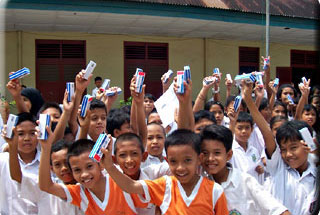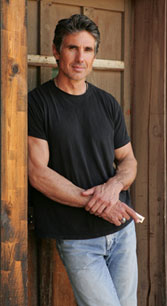THE WHO'S NEWS INTERVIEW
by Anne Walden
 Gary Allegretto, Allegretto Con Amore Gary Allegretto, Allegretto Con Amore
In clinics and classrooms from Indonesia to New Orleans’ ninth ward, Gary Allegretto, ’82 B.S.F., is the ultimate blues traveler.
Gary Allegretto plays the harp. Not the orchestral, angelic kind — although I’m not beyond ascribing celestial motivations to his life’s work — but rather the blues harp, the mouth organ, the purveyor of exuberant soul commonly known as the harmonica. “This cat’s got the goods,” says one amped reviewer; another calls his latest CD, Many Shades of Blue, “a masterpiece... all killer, no filler.” Many Shades of Blue (which includes Gary’s impressive, earthy vocals) debuted at #11 on the Living Blues Radio Charts top 25 for June ’08. But trust me, some truly righteous audio and video links will follow, so you’ll be able to judge for yourself.
This interview isn’t going to be an odyssey through recording sessions and sunglasses-at-nightclubs, peeling off to a roadhouse here and there. Nope. “I’ve always followed my heart in matters of vocation,” says Gary, and his heart has taken him to Harmonikids, his deeply personal and unbelievably effective way of helping children in extremis. The Harmonikids mission is to provide harmonicas to special needs children (i.e., including but not limited to: at risk, disabled, handicapped, abused, neglected, orphaned, underprivileged, traumatized, emotionally disturbed, retarded, autistic, hospitalized, suffering from an illness or disease, requiring medical care, terminally ill) and teach them to play simple songs through gentle instruction. This provides both an educational and entertaining activity for children with tremendous physical and emotional challenges. Using a foolproof teaching method and the irresistible draw of the harmonica’s “size, portability, and voice-like tone,” Gary has become a one-man philanthropic band.
I spoke with Gary just after he had returned from New York City, where he collaborates with the International Modeling and Talent Association (IMTA) for one of two annual Harmonikids fundraisers. The other is in Los Angeles, where he lives when he isn’t on the move. Understand that I usually limit my phone interviews to about 20 minutes, deferring to the interviewee’s likely earpiece fatigue and the threat of too much copy. But Gary couldn’t get me off the phone. I simply had to listen, enraptured, for well over an hour; and I was eventually joined by my office mate. Together we stared at the hypnotic voice embodied by the speakerphone, occasionally breaking off to mouth “Omigosh” or reach for a tissue.
Let’s begin with a typical Harmonikids anecdote: The Child Who Decided That Music Was As Important As Breathing.
* * *
Gary Allegretto: At the Ronald McDonald House here in Los Angeles, a kid in a wheelchair was sitting with his mom at the outskirts of my session. I was teaching all the other kids to play, and I asked the mom, “Does he want to play?” “Oh, he can’t,” she said. “He had a brain tumor and the operation left half of his body paralyzed, and he can’t breathe out of his mouth.” I asked if maybe he just wanted to hold a harmonica, and immediately, with his good hand, he put it to his mouth. His mother said, “Oh wow, he really wants to try it. Let’s see.” And she manually opened his mouth, and then closed it on the harmonica and pinched his nose, and he proceeded to turn red. And I said, “Ma’am, this really isn’t that important.” “Oh, but he just really wants to do it.” Five minutes later, as I was teaching the other kids, behind me I heard this note. I turned around to look, and the kid had this wonderful look of joy on his face, and his mom was crying.
Who’s News (agog): And you said he wasn’t breathing through his mouth before?
GA: She told me that he hadn’t since the operation. Possibly the harmonica inspired him to start breathing through his mouth again. And then he turned to me, and in sign language, waved his hand up and down in front of his face like he was tipping his hat to me. And I asked his mom, “What is he saying?” “He’s saying, ‘Cool, man.’”
* * *
On the “sponsors” page of the Harmonikids website, you’ll find Ronald McDonald House’s corporate logo, as well as trademarks for IMTA, renowned instrument artisans Hohner Inc., and others. I’d assumed that these affiliations represented corporate sponsorship. Nope. “Though the organizations listed have provided assistance — for instance, Hohner provides harmonicas at a special price, and IMTA facilitates a fundraiser at their conventions and has also donated significantly — none of those organizations write us checks regularly,” says Gary. “Mostly they just endorse us as an organization. Harmonikids primarily survives on money that comes from private donations. Unfortunately, it’s a tight budget. I do have a board of directors and webmaster, but basically what I’m doing is just me. I don’t get a salary for Harmonikids, and I would like funding to teach others to do it so there could be Harmonikids chapters all over the country, and maybe even all over the world.”
Gary’s global vision is already more reality than pipe dream, in that it needs no translation. From his Harmonikids tour of tsunami-wracked Indonesia, we derive our second anecdote, A Little Duck Goes a Long Way.
* * *
GA: An interesting thing about music and kids. The songs that we consider American ― “Twinkle Twinkle Little Star”, “You Are My Sunshine”, “Mary Had a Little Lamb”, and even “Shave and a Haircut” (that’s the one I start with generally because it’s so simple) ― kids know them all over the world. They’re not unique to our culture. It’s music as a universal language.
WN: So there isn’t any obstacle with tonalities you have to overcome.
GA: Not with those songs. When I go to a foreign country I’ll play the familiar songs, and they generally know them. I’ll also ask them to sing one that I don’t know. When I was in Indonesia I learned a song that everybody knows and loves there, that we don’t have, mainly because it’s a very culturally different song, although the melody is quite beautiful. It’s called “Potong Bebek Angsa,” and it’s about killing a little duck, putting it in a pot, frying it up and having a party and dancing. These folks struggle to survive every day, and so it’s not unusual that a happy song involves putting a duck in a pot. Every time I played it there, they would smile, anywhere I went, so I knew it was the right one to teach them. It really changes the connection people have with you. When I taught the kids the other songs, they were thrilled, but then when I pulled that one out, they thought, “Wow, who’s this guy from all the way across the world who knows our song?”

You can imagine that at that time [traveling to Indonesia] was pretty chaotic; there was a lot of corruption, and Customs was very hard to get through. More than once I played that song for Customs officers, just to bring a smile to their face, and even gave them harmonicas and encouraged them to play along with me.
WN: An interesting bribe.
GA: It completely changed their stature when they did it. They went from being tough guys to being little kids. That’s what the gift of music does for people in general; particularly for the kids who had experienced something that no kid should ever have to go through, losing everything. I taught at orphanages and refugee camps where the kids had lost not only their homes and possessions, but also their families. They went from post-traumatic stress ― just staring at their feet ― to laughing and giggling and being kids again. I think that’s what music provides not just to children, but to everybody, the joy of being a child.
* * *
Before graduating summa cum laude from NAU’s School of Forestry, Gary was a forest ranger on the Coconino National Forest, and fought forest fires as a Mormon Lake Hotshot. “I loved that work; I loved going to school at NAU,” he says. “Some of my favorite moments in my life were right there in Flagstaff. Lately I’ve been kind of nostalgic about the sunflowers on the mountains; I had a much more intimate experience with the surrounding area than the average person because I spent my days patrolling the national forest, the mountains and the canyons, all the way from the Cinder Hills down to Sedona. That was all part of my patrol, and it’s very close to my heart.”
Although he was on call with the firefighters and also academically focused — he was president of the Forestry Club — he remained a musician. (You can read about his musical genesis at CD Baby ; scroll down to the CD Liner Notes section). “I didn’t have a formal band at the time, but I was sitting in with a lot of friends who had bands at places that probably aren’t there anymore like the Widowmaker Inn, the Alpine Spaghetti Station. In those days I never thought of music as a career, and thought I would do something more practical, like forestry.”
Nevertheless, after graduation and a stint as a forester in Santa Fe, Gary went to New York City, where he worked as a musician. There, he met fellow performer Chris Nuehoff, who also coordinated the children’s playroom at the Memorial Sloan-Kettering Cancer Hospital. “Chris had all these companies donate musical instruments for the kids to play on, keyboards, a drum set, a guitar, and percussion. So we’d have these blues ‘jam sessions.’ Chris would play piano, I’d play harmonica, and the kids would just let it all out.
“It was really fun, but the kids weren’t really playing songs, so to speak, as much as being able to express themselves by making noise on the instruments. And I noticed immediately how drawn the kids were to the harmonica.” And that was the genesis of Harmonikids.
Realizing that the kids would be much more interested if they were more skilled, Gary decided to figure out how to get kids harmonicas and teach them to play songs. His eventual teaching method involved simple harmonica tablature, numbering the harmonica holes and using corresponding numbers on the song sheet. “Though some of these kids don’t have fingers or appendages at all,” adds Gary, “so they find ways to do it. Kids with disabilities ― and this is key to Harmonikids ― concentrate on their abilities, not their disabilities, I think more so than other kids who are less challenged. They’re always told what they can’t do, so when they have a new opportunity to learn something they really focus on it and try to tackle it, and that’s what inspires me the most about them. The heart that they show. They don’t take anything for granted.”
It’s entirely possible that at the time Gary underestimated his idea’s therapeutic benefit. Case in point, our fourth anecdote: The Child Who Gave Gary a Master Class.
* * *
GA: I was going to an Australian Ronald McDonald House, and the woman in charge told me in advance, “I’ve got a kid here already who’s been waiting for you, and he’s so excited. When you get here he’ll be out in the lobby.” And there’s a little kid with an Australian cowboy hat. He’s in a wheelchair, just breathing in and out of a harmonica, making the notes. But then I find out he has cerebral palsy, and he’s blind. Of course it touched me, but it also made me nervous. He couldn’t see the numbers, and he had no coordination to find the numbers and to isolate them. [I found out] that all the other kids were pretty heavy cancer patients. I asked if they had cerebral palsy, and she said no.
I took her aside and said, “To be honest, I’m nervous because I don’t want to embarrass him in front of the other kids. He can’t see the notes and he doesn’t have the muscle control to find them, and I’m afraid that I can’t teach him.” She looked at me and said, “Gary, he’s so excited about you being here, whatever you do he’ll love.” So I just swallowed my pride and said OK.
We went up to the other room, and all the other kids got harmonicas, and we started working on our usual songs, “Shave and a Haircut,” and “Twinkle Twinkle.” And by the time we got to “Twinkle Twinkle,” the little kid had figured out how to find notes by ear. Nobody had ever told him he could do more with a harmonica than just breathe in and out. But he was listening intently to what I told the other kids, and he figured out how to find those notes, and how to make them. He was playing along with “Twinkle Twinkle.” Slowly and with mistakes, but he was getting it. And then with “You Are My Sunshine,” he was so excited, he sang it for everybody. Everybody including me ― including me right now ― started crying. He had such a beautiful voice and such a wonderful heart, and he put everything he had into singing this song to make everybody happy. I really felt bad for these kids because I was there to make them happy, and they were all crying.
WN (mistily): Well, there’s crying and there’s crying.
GA: His mother sent me an e-mail a few years later. It seems he loved country music, and was featured at the Tamworth Country Music Festival ― he actually played on stage.
WN: It’s interesting that in this anecdote you stopped to criticize your motivation, because it sounds to me like you’re very humanitarianly motivated.
GA: I really was just thinking about me and not about what he might get out of it. I was thinking, what if I can’t teach him, which was something I hadn’t experienced before. And I didn’t want to embarrass him, because he had full mental capacity, he just wasn’t able to use his faculties. It was partially my ego and partially my worry of embarrassing him that made me doubt the power of music ― which in itself, even if he hadn’t produced the songs, would have been enough.
* * *
If you’re as intrigued by Gary’s vision as we are, now would be a good time to take a look at his YouTube Video — and then muse about what you might be able to do to help. “My dream for Harmonikids,” says Gary, “is for it to become something I can do fulltime, and have a staff as well. We are a 501(c)(3), but without funding, Harmonikids will stay a grassroots effort. In order for it to go to the next level, I need corporations or organizations that would support us for the tax deduction. I could also use grant writers.” At this point, it was all my office mate and I could do to restrain ourselves from dashing out to Pulliam and hijacking the next flight to L.A.
There’s so much more to Gary’s story. How he managed to get to New Orleans to help Katrina victims, which resulted in an understandable disillusionment with the government and a passionate anthem, “Four Days Late,” that he ended up recording with Ivan Neville. How he wins the trust of kids everywhere by demonstrating how he can play the harmonica with his ear. (Not by ear, but literally with his ear.) How to say “blow” and “draw” in Indonesian. How he was taught an unsettling musical lesson by an autistic savant with cancer. How he slept through his NAU forestry final exam, which spawned a recurring nightmare that he still has today.
Other than that “senior moment,” from which he was rescued by NAU Professor Emeritus Ernie Kurmes, Gary praises NAU for its “unparalleled diversity,” both in nature (“Merriam’s Life Zones were developed in Flagstaff”) and people. “I worked side by side with both Navajo and Hopi Indians, and learned to really appreciate their cultural beauty. That religious and cultural tolerance is more important than ever in our world today. To me it’s the difference between life and death these days, and between peace and war.

“At NAU I got a lot of inspiration for who I am, a solid foundation, and when I need it, I draw on those experiences. And often I do need it; when you venture far and wide, it’s a crazy, mixed-up world.”
And that is Gary Allegretto, rendering his personal motif with a simple, artless, innocent style, with passion and expression — allegretto con innocenza, con abbandono edspressione. He plays the classical blues with a joyful difference, and that’s music to everyone’s ears.
To read more about the Harmonikids Katrina and Tsunami Relief projects, visit www.harmonikids.com and click on “Projects.” For more on Gary’s music, visit his website , or his press kit . Many Shades of Blue is available through CD Baby and iTunes.
# # # |
|
|



 Gary Allegretto, Allegretto Con Amore
Gary Allegretto, Allegretto Con Amore
